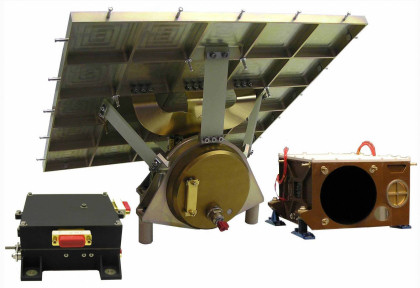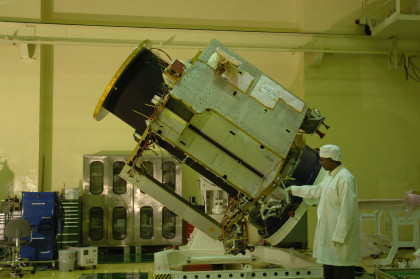Sucessfully Launched!
Press Release 15 - 20th October 2008
Max Planck flies to the Moon
An infrared-spectrometer from the Max Planck Institute for Solar System Research is taking part in India's first mission to the Moon
India's first mission to the Moon, Chandrayaan-1, is scheduled to take off from the Satish Dhawan Space Center on the south-eastern coast of India on Wednesday, October 22nd, at approximately 3.00 A.M. The German science and technology contribution to the mission is represented by an infrared spectrometer designed and built by the Max Planck Institute for Solar System Research (MPS) in Katlenburg-Lindau together with the University Bergen in Norway, the Polish Institute for Space Research PAS in Warsaw and the University Maynooth in Ireland. The spectrometer will play a fundamental role in the production of the first high-resolution global mineralogical map of the Moon.
The Moon is crucial to the understanding of the Earth's history. While both originated about 4.5 billion years ago, evidence of these early times has been mostly erased on Earth by tectonics, weather and life. On the Moon these signs have been preserved in the geological and mineralogical composition, like in a fossil. Past lunar missions, however, have succeeded only in studying selected areas of the Moon's surface. These missions were often very limited in time and instrumentation or had an elliptical orbit that in part carried the space probe far away from the Moon.
Chandrayyan-1 will accompany the Moon for two years. The mission will benefit from a low circular orbit of 100 km above the surface and a complementary array of several new and advanced scientific instruments. In particular, this will allow the infrared spectrometer SIR-2 from MPS to help map the main mineralogical components of the lunar surface with unprecedented reliability and resolution.

|
Figure 1: The infrared spectrometer SIR-2 will help to create the first nationwide mineralogical map of the moon.
|
(Image: MPS/ISRO)
|
The SIR-2 works by exploiting the optical properties of mineral components within lunar soils. Like a leaf, that absorbs all colours of the rainbow except green, the minerals each absorb specific wavelengths of sunlight which are not reflected back into space. In order to find these characteristic gaps SIR-2 splits the reflected lunar light into is components, like a prism resolving sunlight into a rainbow. The missing wavelengths point the scientists to the mineralogical composition of the Moon's surface.
Since the characteristic "colours" of the main minerals found throughout the solar system lie beyond red in the longer wavelengths called infrared, SIR-2 is optimized to work with these wavelengths. SIR-2 is the product of an on-going research and application programme at MPS aimed at developing and producing state-of-the-art and increasingly sophisticated range of spectrometers operating in the visible to near infrared.

|
Figure 2: A scientist in the integration of the infrared spectrometer SIR-2 on the satellite, which flies to the moon on Wednesday.
|
(Image: MPS/ISRO)
|
All in all, eleven scientific instruments are part of the Chandrayaan mission. Five of them were built in India, the others were developed by international research teams. Apart from the mineralogical mapping of the lunar surface, other scientific aims include a high-resolution, three-dimensional map of the lunar topography as well as the confirmation and location of frozen water. Past missions have already found evidence for ice on the banks of certain craters in the polar regions.
The development of SIR-2 was made possible by funding by the Max Planck Society and ESA and represents the growing relationship between the Max Planck Society and India. As a sign of this esteem, scientists from MPS were the first foreign researchers that were allowed to calibrate their instrument in India.
Further Information
 Here you will find an essay on lunar science as well as background information on the origin and evolution of the Moon and on remote sensing. In addition, there are schematics and cartoons of the inner workings of SIR-2. On 'Press Pack' you will also be able to download an extended introduction to the Chandrayyan-1 mission, typed educational sections, and the official mission logos.
Here you will find an essay on lunar science as well as background information on the origin and evolution of the Moon and on remote sensing. In addition, there are schematics and cartoons of the inner workings of SIR-2. On 'Press Pack' you will also be able to download an extended introduction to the Chandrayyan-1 mission, typed educational sections, and the official mission logos.
Contact
Dr. Birgit Krummheuer
Public Relations, Press Officer
Max Planck Institute for
Solar System Research
Max-Planck-Straße 2
37191 Katlenburg-Lindau
Tel.: +49 5556 979 462
Mobil: +49 173 39 58 625
Fax.: +49 5556 979 240
Email: Krummheuer@mps.mpg.de
Dr. Roberto Bugiolacchi
Max Planck Institute for
Solar System Research
Max-Planck-Straße 2
37191 Katlenburg-Lindau
Tel.: +49 5556 979 161
Mobil: +49 152 2763 28 78
Fax.: +49 5556 979 240
Email: Bugiolacchi@mps.mpg.de
